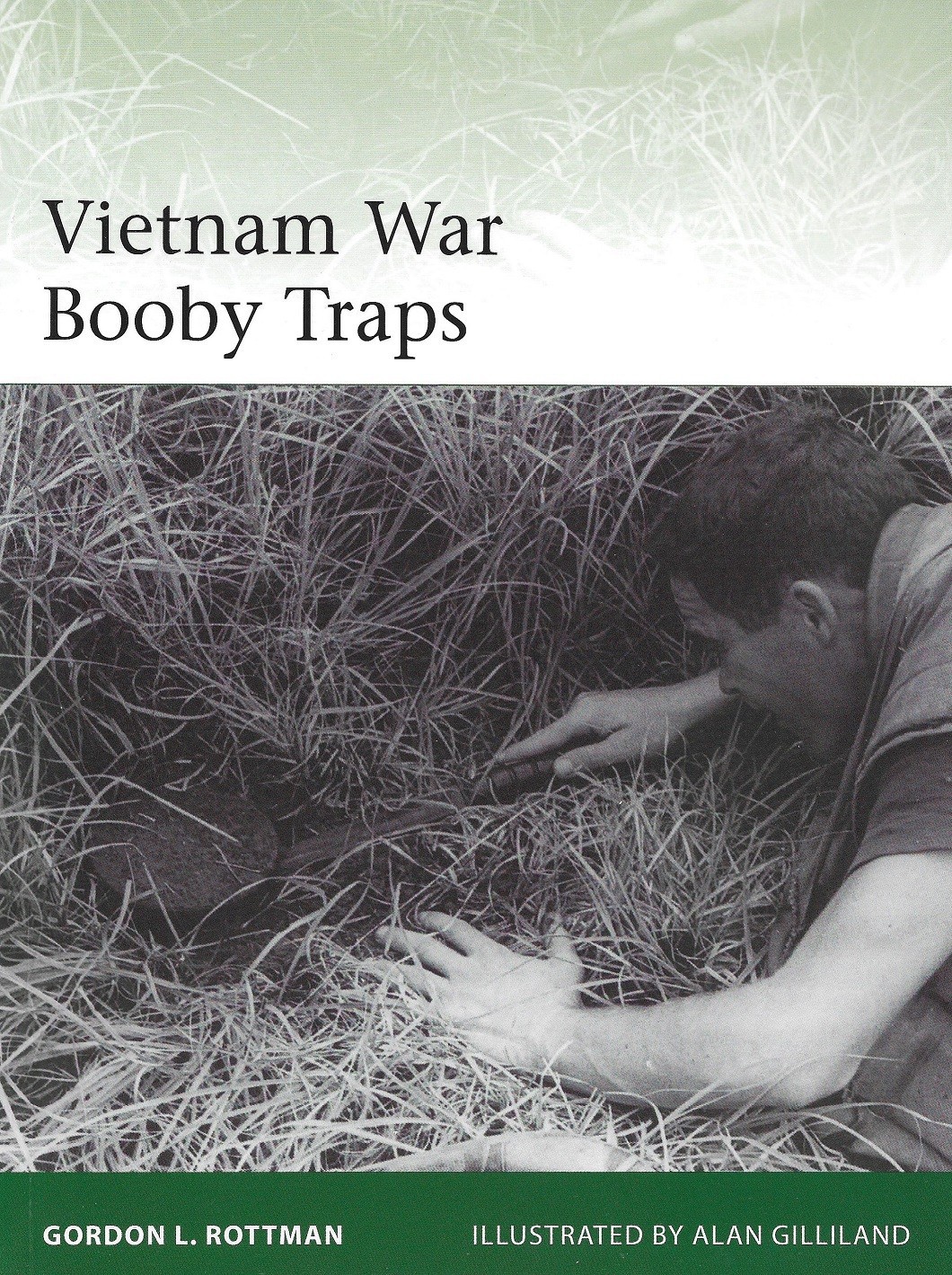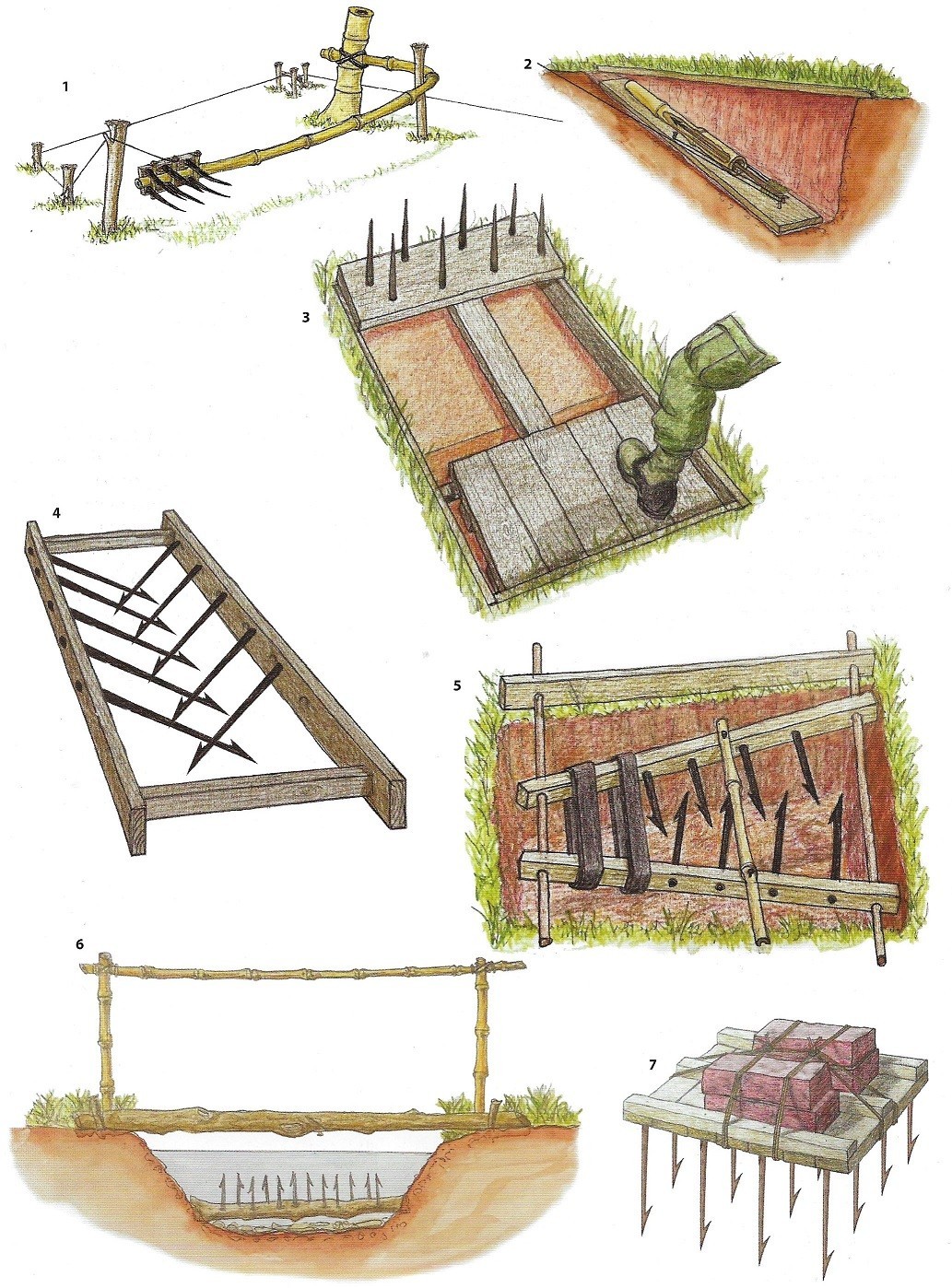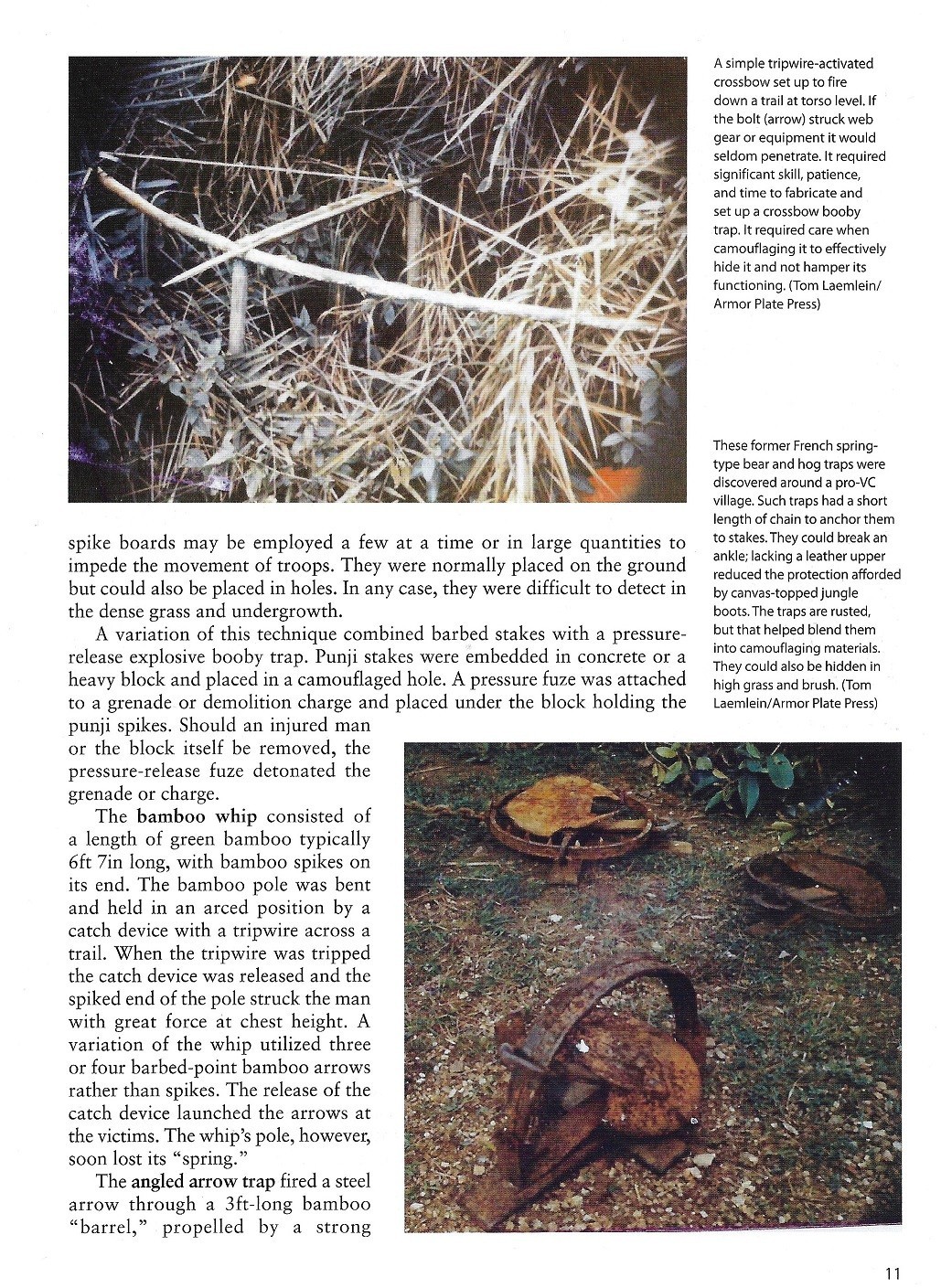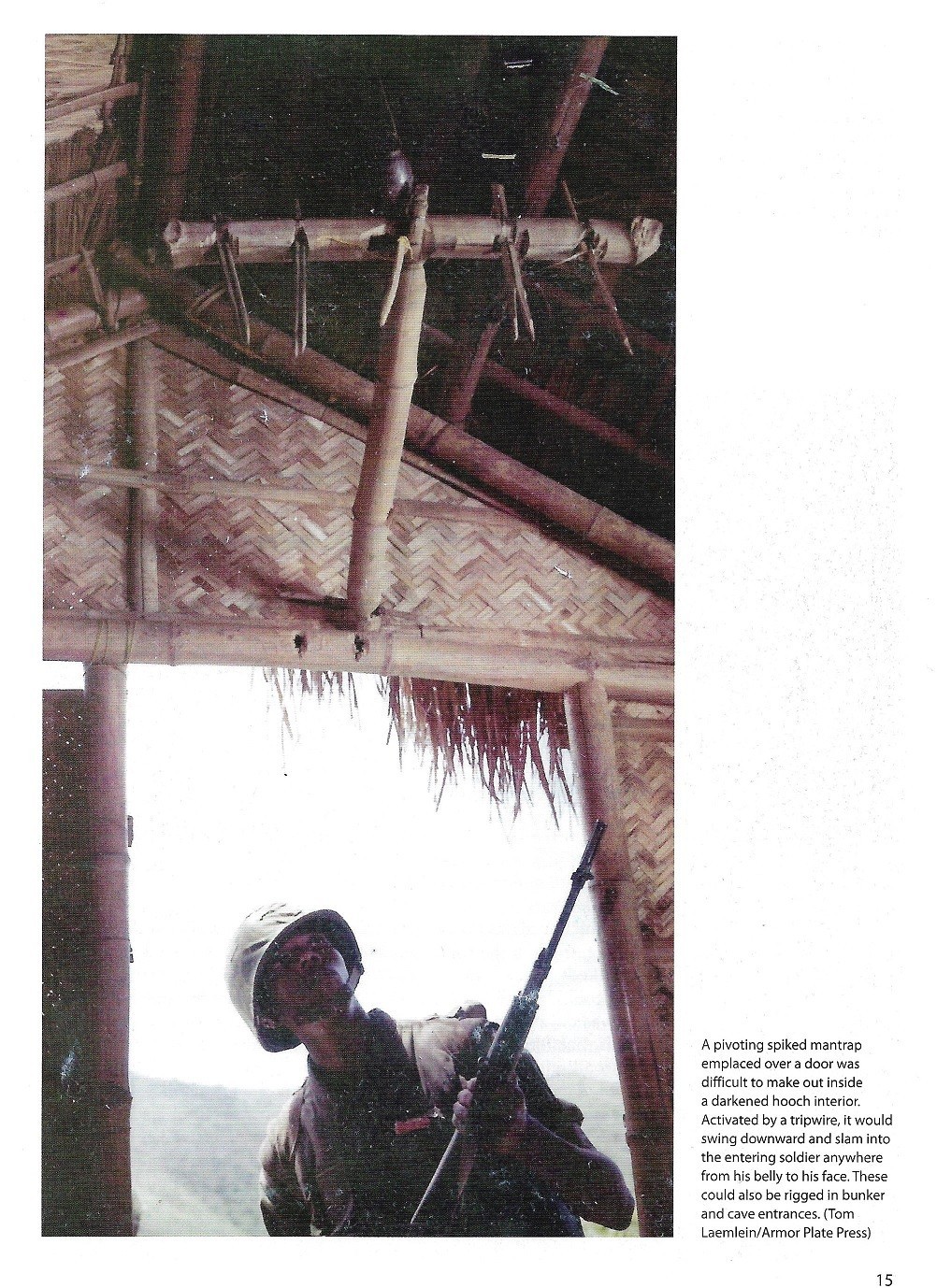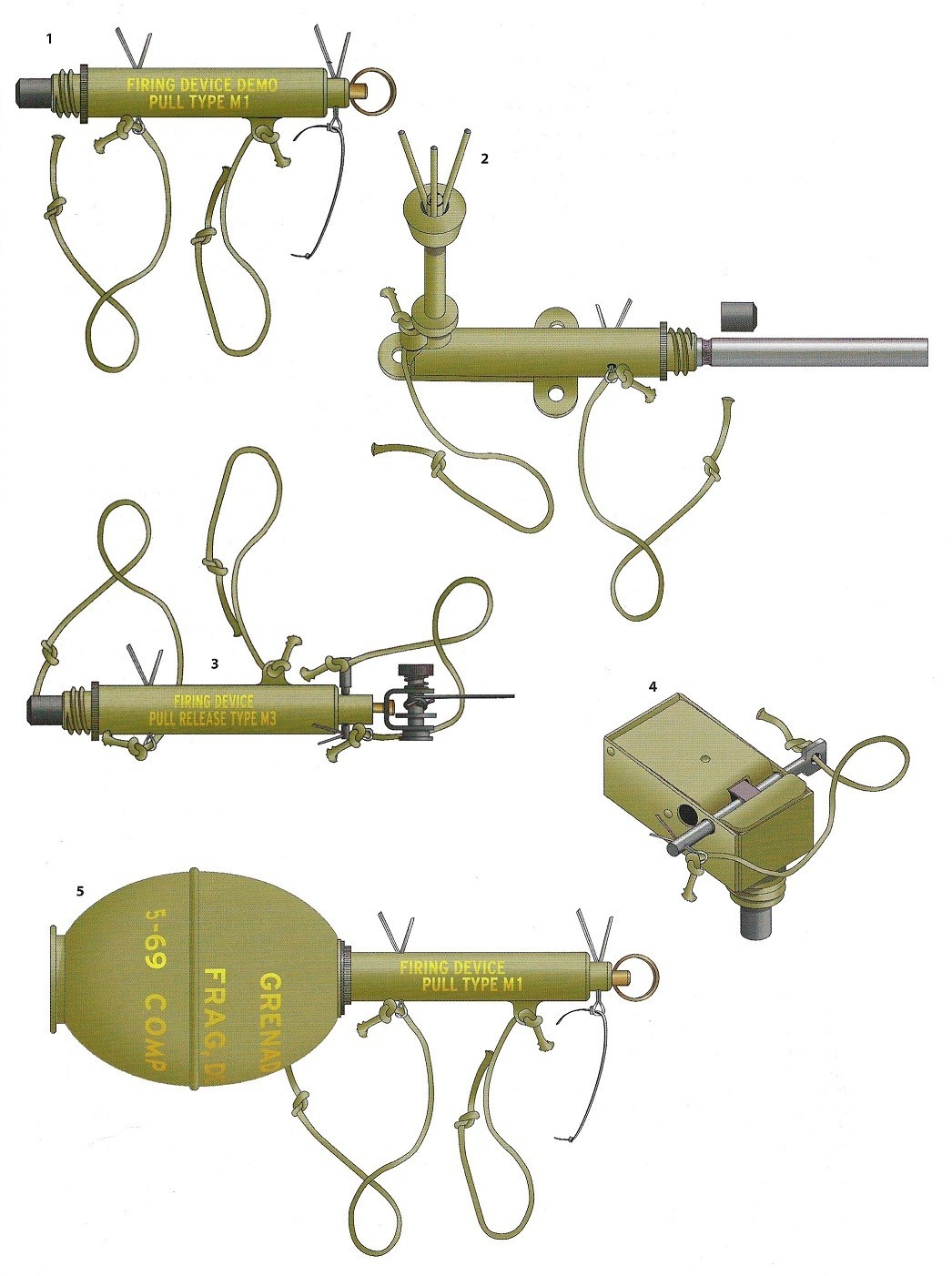
HISTORY:
** The Vietnam War was the first conflict in which booby traps played a leading role. Unable in most instances to hold their own in standup fights against US and other Free World forces which were superior in strength, firepower, mobility, and logistics, the Viet Cong relied on traditional guerrilla warfare tactics. Employing small-scale hit-and-run attacks, ambushes, terrorist actions, and precision attacks against bases during which they controlled the surrounding area, the Viet Cong favored means that allowed them to avoid direct enemy contact. These included one of the oldest guerilla weapons – booby traps. These could be incredibly simple or startlingly complex and ingenious, ranging from pointed sticks to command-detonated submerged floating river mines. Besides a wide variety of booby traps the Viet Cong also used land or water mines, both contact/pressure-detonated and command-detonated. In this book, a Vietnam veteran examines the various types of booby traps used by the Viet Cong, as well as the countermeasures employed by their Free World opponents, including landmines, early warning devices, and means of detecting booby traps.
** Quoted from the back cover of the book.
THE BOOK:
Osprey Publications has released Vietnam War Booby Traps as Number 236 in their Elite series. It is a soft cover book with 64 pages. Included with the text are black and white photographs and color photographs, color illustrations, detailed captions and more. It has a 2020 copyright, a publication date of October 29, 2020 and the ISBN is 978-1-4728-4245-9. This informative book details the development, construction, use, impact, and legacy of the booby traps used by both sides of the conflict during the Vietnam War.
THE CONTENTS:
- Introduction
- Non-Mechanical Booby Traps
- Mechanical or Non-Explosive Booby Traps
- Hand Grenades as Booby traps
- Explosive Booby Traps and Mines
- The Military Use of Booby Traps
- Searching for booby traps
- Detection techniques
- Mine detectors
- Road clearing
- Manual disarming
- Casualties
- Free World Forces’ Mines and Booby Traps
- Installation defense
- Claymore mines
- US antipersonnel mines
- Conclusion
- Bibliography
- Index
THE TEXT:
Author Gordon L. Rottman provides an excellent written history of various booby traps used by both sides of the conflict during the Vietnam War. Great detail is provided for each of the many types of booby traps discussed. The details include how the various traps were built, how they were placed and hidden, materials and items there made of such as bamboo and captured and repurposed grenades and artillery shells, how the traps were activated, what the intended effect of the traps were, elements and conditions that could affect the traps, how the traps could be disarmed and other such pertinent information. When detailing the various types of hand grenades used by both sides of the conflict for booby traps the author goes into such details such as their construction, the effective radius of the various types, to how long each of the various types of fuses would burn before activating the explosive, etc. One of the enemy booby traps described that I found to be very interesting was the anti-helicopter grenade launcher which was a board with nails driven into which held hand grenades in place with the pins pulled and an explosive charge was placed underneath it and when detonated it would throw the grenades into the air with the intended purpose of damaging helicopters and killing or injuring personnel when they detonated. Another type of booby trap detailed that I found to be interesting were French made spring-type bear and hog traps. Some of the types of devices used by the free world forces that are described are the US M18A1 Claymore antipersonnel mine, M14 “toe-popper” antipersonnel mine, and M49A1 surface trip flare. Booby trap detection is covered very well and describes the various levels and sophistication of the different types of techniques put into use by the free world forces. Some of the various detection techniques describes are as simple as individuals visually detecting booby traps, to using fishing line hung from the end of rifle barrels with a shell casing or pebble tied to it to detect trip wires, to the use of homemade grappling hooks drug through ditches by hand along roadways to locate electric cables used for command-detonated explosives, the use of explosive-detecting dogs “bomb sniffers”, to the use of electronic mine detectors such as the AN/PRS-3 “Polly Smith” metallic mine detector up to the use of something as large as Caterpillar D7E Rome Plow bulldozers fitted with heavy-duty12 foot wide KGBA7E clearing blades. One of the most unusual items that is described by the author is the use of the XM-2 personnel detector manpack, or E63 manpack personnel detector “People Sniffer” by the American military, which proved to be an impractical device for its intended purpose, but shows the ingenuity that was put into that type of warfare. The text in the book is nicely written and well detailed. As I read through the text, I didn’t notice any spelling errors but I did find a few grammatical errors in the form of missing punctuation which created some run on sentences. Also, on page 57, when describing rattle traps, it states “when brushes were blown against the wire”. It should be “bushes” or “brush” not “brushes”. Grammar and spelling might not be an important factor to everyone however it is something that I take notice of and pass on my findings. I feel that if the text is well written then it shows that the author has taken the time to be professional with their writing. Anyone wanting to add an excellent reference and history book on booby traps used by both sides of the conflict during the Vietnam War to their personal library will be pleased with this very informative and interesting book.
THE PHOTOGRAPHS:
A total of 18 black and white photographs and 27 color photographs are included in this volume. The majority of the photographs are close-up detailed photographs of the various types of traps, friendly or foe, being discussed and allows the reader to see what type of trap it is, what was used in the trap, the way it was constructed and camouflaged, how it was set and how it would be triggered. Several of the photographs are of reconstructed booby traps that were made and photographed by the author. Other photographs throughout the volume are from period photographs as well as illustrations taken from military manuals that were published during the conflict. I would say that the photographs that were chosen for this book were for the most part lesser-known photographs as opposed to photographs that are featured in many other titles that deal with the same subject matter. The majority of the photographs are clear and easily viewable, however a few have an out of focus look to them and some appear to be too dark, and others appear too light, however they do not take anything away from the book. Author Gordon L. Rottman stuck to the title of the book and chose subject specific photographs and did not include photographs that strayed from the main subject of the book. The majority, if not all, of the photographs will prove to be a wealth of information to anyone interested in booby traps used by both sides of the conflict during the Vietnam War due to the details they contain.
THE ILLUSTRATIONS:
There are 8 pages of color illustrations by illustrator Alan Gilliland included in this volume. The illustrations are very well done, nicely detailed and are of:
Plate A
VC Mechanical or Non-Explosive Booby traps
Plate B
US Demolition Firing Devices
Plate C
VC Explosive Antipersonnel Booby Traps
Plate D
VC Explosive Antivehicle Booby Traps
Plate E
VC Booby Traps in and Around a Base Camp
Plate F
Road Mines and Booby Traps
Plate G
Booby Traps in a VC Village
Plate H
Free World Booby-trap Devices
THE CAPTIONS:
The captions are well written and explain the accompanying photographs and illustrations in great detail eliminating any doubt as to what is shown. The captions go into very specific detail as to the specific type of booby trap shown, what it was made of, how the trap would be activated, what the intended effect of the trap would be, how the trap could be disarmed and other such pertinent information. I did find one error in a caption accompanying a photograph of a “Venus Flytrap” on page 12. Part of the caption describing how the trap works it states “the spikes to tear into the angle or calf”. It should state “ankle” not “angle”. I was impressed by Gordon L. Rottman’s captions as they are very helpful to the reader due to their detailed content as opposed to other captions that I have seen that are very brief and lack pertinent information.
Osprey Publishing also offers Vietnam War Booby Traps as:
eBook (ePub) ISBN: 978-1-4728-4246-6
and
eBook (PDF) ISBN: 978-1-4728-4243-5
Osprey Publishing’s, Vietnam War Booby Traps is also available as a Kindle version through Amazon.
PRICE:
UK £12.99 / US $20.00 / CAN $26.99
This book was provided to me by Osprey Publishing. Please be sure to mention that you saw the book reviewed here on the KitMaker Network when you make your purchase. Thank you.
